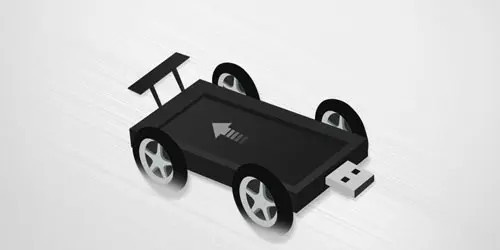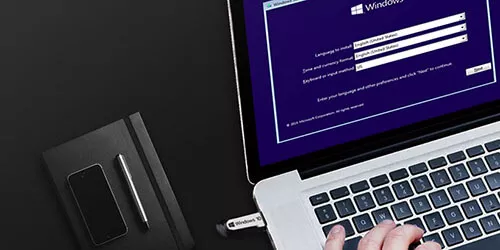How to Choose the Best File System for USB Flash Drive on Windows10?

A file system seems like come to people only when they need to reformat something. In fact, it's essential for USB flash drive which we use almost everywhere. And it plays an important role in USB drive normal function. If you launch an inappropriate file system on your USB flash drive which the device trying to read or write files in the drive doesn't support, it will be a crash. So, it's crucial to choose the right file system for your USB flash drive. That is why this article is trying to make you get closer to file system through several parts so that you can choose the right one for your USB flash drive.
What is a "File System"?
A file system defines a way of organizing and storing files on a hard drive. It also defines a way to store data about these files - for example, their names, permissions and other attributes. Different file systems provide different ways.
An operating system needs to understand a file system of drives so it can write data into the drives and read files. If the operating system doesn't get to the file system, user can't use that file system with that operating system or they may need to install the specific file system driver.
Three file systems - NTFS vs FAT32 vs exFAT - for USB flash drive
For Windows, there are commonly 3 file systems - NTFS, FAT32 and exFAT. With one of these file systems, USB flash drive could be smoothly recognized, read and written. A file system can be so exclusive to Windows that a USB with it cannot be normally used on other operating systems. It's not convenient but safe. It's NTFS. And the other two, may be compatible with more devices or operating systems, but have their own disadvantages.
NTFS |
FAT32 |
exFAT |
||
Compatibility |
Low |
High |
High |
|
Support OS |
Windows |
Mordern versions of Windows (versions from Windows XP); Readable & Editable |
All versions of Windows; Readable & Editable |
All versions of Windows; Readable & Editable |
Mac OS |
Read-only |
Readable & Editale |
Modern versions of Mac OS X; Readable & Editable |
|
Linux |
Some Linux distributions; Read-only |
Readable & Editale |
Fits in Linux with particular software; Readable & Editable |
|
File Size Limit |
No realistic limits |
4GB |
2TB |
|
Security |
Supports file permissions |
Lacks permissions and other security features |
Optional support for access controllists |
|
New Technology File System (NTFS)
NTFS is the modern file system Windows tends to use by default. Windows will format system drive with the NTFS file system while it's being installed.
NTFS Pros and Cons:
NTFS Pros:
- For security, it supports file permissions.
- A change journal that can help quickly recover errors if computer suddenly crashes.
- No realistic limits for file-size and partition-size.
NTFS Cons:
- Poor compatibility. It almost only works with all versions of Windows, but read-only with Mac and may be read-only with some Linux distributions.
Usage Advice: Due to its lack of compatibility, it's not that practical to launch it on a USB flash drive. Mostly, it is used in Windows internal drives. However, if you're just using a USB flash drive on Windows, for security reason, it also makes sense that you format the USB with NT file system.
File Allocation Table 32 (FAT32)
FAT32 is the oldest of the three file systems available to Windows. It was introduced all the way back in Windows 95 to replace the older FAT16 file system used in MS-DOS and Windows 3.
FAT32 Pros and Cons:
FAT32 Pros
- Works with all versions of Windows.
- Fits in almost all kinds of devices with a USB port.
FAT32 Cons
- Size of individual files on a FAT32 USB flash drive is up to 4GB.
- Lacks the permissions and other security features.
Usage Advice:If you don't have files larger than 4GB or confidential ones, FAT32 is perfect for your USB drive because of its amazing compatibility. After all, our intention of transferring data through USB flash drive is exactly due to its compatibility.
Extended File Allocation Table (exFAT)
The exFAT file system was introduced in 2006 and was added to older versions of Windows with updates to Windows XP and Windows Vista. exFAT is optimized for flash drives - designed to be a lightweight file system like FAT32, but without the extra features and over head of NTFS and without the limitations of FAT32.
exFAT Pros and Cons:
exFAT Pros:
- Large limits on file and partition sizes.
- More widely-compatible than NTFS, works well on all versions of Windows and modern versions of Mac OS X and fits in Linux with particular software.
exFAT Cons:
- (If there has to be one) Cannot match the compatibility of FAT32.
Usage Advice: Use it when you need bigger file size and partition limits than FAT32 provides and when you need more compatibility than NTFS offers.
Other
If you need to switch the file system of your USB flash drive, follow steps below:
Right-click your USB flash drive, choose Format…
Select the file system you want in the drop-list of File System.
But before formatting, you may love to back up files in the USB drive first. CloneGo, an easy and useful system and partition clone software, can help you with that.
How to choose the best file system for USB drive on Windows 10
To choose a right file system for USB flash drive, you should understand what a file system is.
For USB flash drive often used on Windows 10, we commonly format it with one of three file system - NTFS, FAT32 and exFAT.
If you require security and only use a USB on Windows 10 system, NTFS is a nice choice.
If you want to save files can be available to various devices or operating system, FAT32 and exFAT are suggested. Plus, if there's a file larger than 4GB that you want to transfer to USB drive, choose exFAT.




















